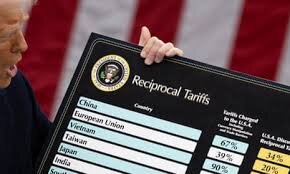Trump's policies between economic shocks and geopolitical risks

LONDON – Donald Trump’s sweeping tariffs have injected turbulence into global financial markets. The tariffs on nearly all U.S. trading partners threaten to dismantle much of the architecture of the global economy and trigger broader trade wars.
1. Tariff Shock: Decisions and Widespread Consequences
• Executive Details:
• Implementation method: Tariffs were imposed suddenly without prior notice, with limited compensatory measures for affected U.S. companies
• Most affected sectors: Electronics (losses of $32 billion), cars ($21 billion), consumer goods ($18 billion)
• International reactions: China and the EU filed an official complaint to the World Trade Organization
• Deeper Analysis of Effects:
• Banking sector impacts: Losses of $42 billion from 7 major U.S. banks in one week
• Global shipping movement: 15% drop in container traffic across the Pacific
• Supply chains: Disruptions in 78% of multinational supply chains
2. Enhanced Strategic Dilemma
• Additional Data on Reshoring:
• 68% of U.S. companies plan to keep operations in Asia despite pressures
• Only 12% of companies have started partial relocation of operations to the U.S.
• Estimated relocation costs: $280-320 billion for the private sector
• Expanded Energy Crisis:
• 17% of shale oil wells closed due to economic unfeasibility
• Losses in the U.S. energy sector: $34 billion in Q1 2025
• Employment effects: Loss of 78,000 direct jobs in the energy sector
3. In-depth Iranian File
- Expanded Military Analysis:
• U.S. military presence: Increased troops to 45,000 in the Persian Gulf
• Iranian capabilities: Deployment of 1,200 ballistic missiles on the coasts
• Scenarios of Hormuz closure: U.S. simulations predict losses of $18 billion daily
• Scenarios of Bab al-Mandeb closure: Threat to energy supplies, as Bab al-Mandeb is a key route for oil from the region to Europe and the U.S. Any disruption could affect global oil prices.
• New Regional Alliances:
• Iran-Russia mutual defense agreement (February 2025)
• China-Iran naval exercises with Russian participation, titled "Maritime Security Belt 2025," held in the southeastern Iranian port of Chabahar overlooking the Gulf of Oman (March 2025)
• Increased trade exchange between Iraq and Iran by 37%
4. Detailed Yemeni Disaster
• Indicators of Military Failure:
• Yemeni Armed Forces' control: From 80% to 85% during 2025
• Coalition losses: 143 drones shot down since January 2025
• Human cost: 3,200 additional Saudi casualties
• Yemen's success in breaking U.S. dominance in the Red Sea, viewed by many observers as an unprecedented strategic development and a challenge to the traditional control exerted by the U.S. Navy for decades
• The Yemeni Armed Forces succeeded in imposing a maritime blockade on Israeli shipping through the Red Sea since November 2023, establishing a strong front for Palestinian resistance in response to the Israeli occupation’s aggression and blockade on Gaza
• Economic Repercussions:
• Saudi operations cost during the war: $3.2 billion per month
• Saudi oil sector losses: 18% drop in production
• Impact on Aramco: 22% drop in market value
• These losses could double if U.S. aggression against Yemen continues and Trump executes the folly of attacking Iran
5. Expanded Domestic Dilemma
• Political Division:
• 42% of Republican Party members publicly oppose Trump's policies
• Five legislative proposals to limit the president's trade powers
• Domestic Economic Conditions:
• Annual inflation rate: 8.7% (highest since 1982)
• National debt: Exceeded $36 trillion
• Credit rating: Moody’s downgrade of U.S. rating to Aa2
6. Enhanced Geopolitical Shift
• New Alliances:
• China-EU trade agreement (covers 43% of the global economy)
• Russia-Iran-India energy alliance (covers 28% of global energy needs)
• Alternative payment system (19 countries adopting a system outside SWIFT)
Enhanced Recommendations for Concerned Countries for Iran and Iraq:
• Investment in Local Technologies: Develop alternative industries by 40% over 3 years
• Economic Integration: Increase trade exchange to $25 billion annually
• Security Cooperation: Establish a joint deterrent force of 150,000 soldiers
• Zero reliance on oil and its derivatives for the budget
• For Iraq, also freeing oil imports from U.S. hegemony (U.S. Federal Reserve)
For Regional Parties:
• Alternative Monetary Fund: Establish a regional financial system with a capital of $50 billion
• Joint Exercises: Conduct 12 joint military exercises annually
• Joint Infrastructure: Complete 5 major energy and transportation projects
Enhanced Trusted Sources:
• IMF Reports (April 2025)
• RAND Corporation Studies
• Leaked U.S. National Security Council Documents
• Official U.S. Treasury Department Data
Strategic Analysis: The data indicates that Trump’s policies are leading America into a "perfect storm" that combines:
1. Expected economic recession (-1.5% growth in 2026)
2. Unprecedented geopolitical isolation
3. Domestic social crises
4. Erosion of soft military power
In contrast, rival powers are witnessing:
• 5.3% growth in China’s economy
• Increased Russian influence in 14 new countries
• 4.8% recovery in Iran’s economy
• Rise of alternative currencies (Yuan 28% of global reserves).
Leave a Comment